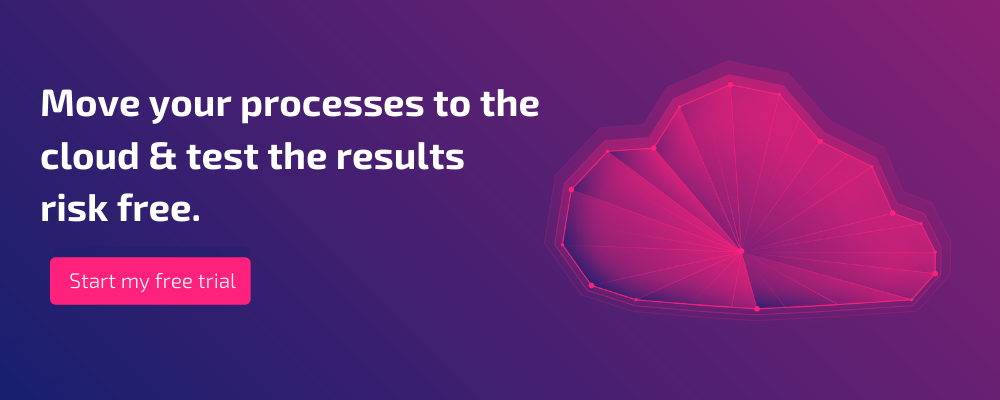Moving to the cloud: A step-by-step guide for surveyors

Not long ago, if you were a surveyor, you would have had to work hard to explain precisely why you would adopt cloud for applications or infrastructure. Not anymore, surveyors have to play catch up. Cloud transformation has been impacting industries across the economy. 92% of organisations use the cloud, and investment is increasing.
Over the last half-decade, surveying technology has begun to embrace the cloud in ways previously unseen. The rollout of 5G is adding to the value of cloud-based tools — even in the field. Advancements in algorithms have expanded the application of cloud technology in point cloud processing, and the need for cloud-enabled platforms like BIM is increasing its use.
In order to embrace the cloud to full effect, it’s critical to do so with purpose and planning. Surveyors need to invest in the right tool and use the cloud in the right way in order to achieve positive outcomes. Here, we are going to walk through those steps and help you transform surveying best practices.
Additional reading: If you want more detail on the possibilities provided by the cloud, check out our free ebook — Are You Ready for The Cloud? A Surveyor’s Guide to the Future of 3D Laser Scanning.
Step 1: Know why you are adopting the cloud the first place
Many companies originally moved to the cloud to save money, using cloud computers like a utility service. While the cloud offers the potential of cost savings, it can be a double-edged sword. The Jevons’ Paradox states that if you make something more efficient, you'll use more of it — and this applies to the cloud in spades. Respondents to the Flexera 2020 State of the Cloud Report expect to increase cloud spend by almost 50%, but they still struggle to forecast accurately. For surveyors, this is especially true when trying to satisfy the increasing demand for scans, especially for BIM (Building Information Modelling) projects.
To realise the real benefits of cloud computing look to agility, scalability, and future potential.
Throw more computing power at your job
Unlike traditional hardware, the cloud offers scalable computing power. This means you can expand your capabilities to match specific job requirements. For large data sets, this provides a significant advantage, and the possibility to dramatically accelerate point cloud processing. However, your ability to effectively take advantage of this opportunity does come down to the software you deploy — more on that in the next section.
Share data with many stakeholders
Once you have your data stored in the cloud, you can share that information easily with colleagues and clients — all with secure administration permissions and encrypted data.
Get access to the latest, most exciting new tech advances
You can get up and running with new cloud-based applications in far less time than a standard installation process. For example, with Vercator, you can set up an account and be aligning point cloud data created by a LiDAR scanner within minutes. There is no traditional procurement or provisioning processes to get in the way, and a lot of cloud applications work on a pay-per-use basis
New developments in surveying will often appear cloud-first, fully provisioned for you to use and evaluate. And any updates to your existing software will automatically be rolled out within the cloud-based version of that software.
Step 2: Change your thinking — software over hardware
In many industries, there has been a shift of capabilities over time from hardware-based to software-driven. Hardware devices have become standardised, with intelligence and differentiation transferring to a more cloud-based software platform.
In surveying, improvements within cloud infrastructure and registration software have resulted in point clouds moving to the cloud. For example, it’s only been because of advancements in multi-stage and vector-based registration algorithms that it’s possible to take full advantage of cloud scalability. Making the right software choices is critical to engaging with the cloud to its full potential.
Cloud tools also bring access to a number of cutting-edge options and technologies. For example, at Vercator, we have a pipeline of advanced options made possible by cloud computing. These include:
Visualisation and animation
Our new visualisation service will enable you to view a scene from each scan location, transition or walk between scan locations, take discrete measurements, and create animated fly-throughs through the whole point cloud.
Data classification
With the Vercator cloud classification service, you will be able to specify an object, e.g. a road sign or a chair. The point cloud will be analysed, objects discovered, and then automatically logged into a database — using cloud technology that is easily updatable and accessible.
Object extraction
The classification of smaller subsets from within larger point clouds will enable items to be categorised. With our object extraction service, you will be able to extract out key primitives, e.g. surfaces (floors, walls, and ceilings), pipes, structural components, etc. Functionality will eventually extend to enable the modelling of all classified objects.
Step 3: Don't take your baggage with you
Cloud computing is not just about moving computing, storage and apps off-premises. Focusing solely on technology without process reengineering is a waste. You need to think about how you can update your processes to align with the new technology at your disposal.
The cloud is powerful, and small teams can quickly produce some fantastic results. But processes have to change to match the potential of the cloud, otherwise the opportunity will be lost. For example:
- Assess workflows: How does the cloud change the order of operations, or which tools you engage with? Using cloud-based software makes it possible to do more in the field, share files more effectively, and scale resources to match demand.
- Improve collaboration: The cloud simplifies the sharing of assets, but also makes it far more practical to collaborate on a single project over distance. You should think about how specialisation, expertise, and tasks can be shared more effectively using the cloud.
- Use of technology: You need to consider the capabilities of the technology at hand. For example, the scalability of resources in the cloud is only valuable if you actually take advantage of it — both by considering the software you use, and then assessing the processes that you have in place.
The COVID pandemic has speeded up the transition to the cloud. It’s also revealing the weaknesses of doing things the old way. For example, these days, you can't just walk down the hall and reboot the machine.
There is an argument for updating procedures and governance before moving any workloads to the cloud. But if you're open to more agile change, piloting and controlled experimentation may be the best way forward.
Step 4: Experiment and learn
Cloud-first surveying applications are becoming more prevalent. Across the economy, 46% of cloud-based applications are now purpose-built for the cloud — surveying tech is following the same trajectory. The outcome is the ability to deploy new reality capture technology more flexibly and within more contexts.
A key benefit of cloud computing is that you can try out a service for a relatively low cost, find out how it works, and how it might benefit your company. You simply sign yourself up for the service.
The best advice is to start. There is already a range of software tools available to get started on your journey to the cloud. Established players like Autodesk, Faro and Trimble, for example, are already offering cloud-based solutions. Many provide a free trial – you can try Vercator services in the same way
Cloud-based advances can also be made in conjunction with investments in a number of additional emerging trends in surveying. For example, SLAM (Simultaneous Localisation and Mapping) can benefit from cloud storage and processing power. The cloud also makes it easier to engage with the application of drones.
Robotics is beginning to move from promise to show real potential — and surveyors are needed to help guide robotic application, partially in the constitution industry. There are always dancing robots to consider. But automated bricklaying and site-walking may be more relevant.
The future remains up for grabs
The move to the cloud is a fundamental shift that surveyors will not be expected to capture in one single move. It’s a process that the industry needs to undertake. But the impact should not be underestimated. The use of cloud technology is improving workflows, streamlining processes, increasing collaboration and opening new possibilities for the effective application of reality capture technology.
Fundamentally, the cloud makes it far easier to embed survey technology within other industries. Again, the construction industry is where we currently see the largest number of developments. Surveyors are increasingly called upon to help with initial planning and then deliver as-built verification information during the construction phase and record changes throughout the built asset's lifetime. The cloud is making this cost-effective, and simplifying the process of accessing and using this data.
Without the cloud, it is almost impossible to envisage surveyors being able to capture all of the opportunities presented by 2021. But it does remain up to individuals to use the cloud effectively to drive change. Start now, and by following these key steps, you will be well on your way. If you want to understand more about the possibilities of the cloud, check out our free ebook —Are You Ready for the Cloud?— of experiencing the possibilities yourself with a free trial of Vercator.
Tags: pointcloud, surveying, surveyors, Vercator, cloud

